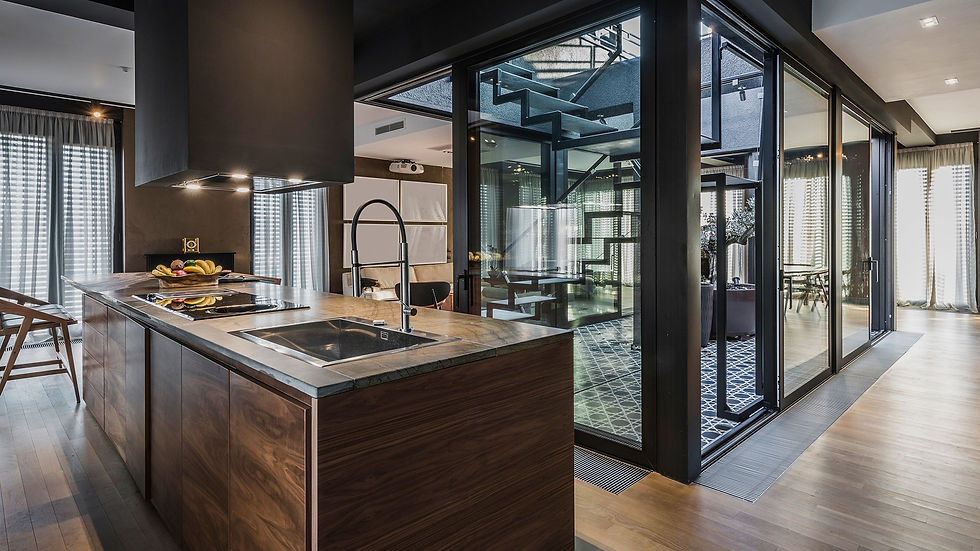The Power of Lighting in Interior Design: Illuminating Your Space with Style and Elegance
- BLOU INK

- Feb 10
- 3 min read
Updated: Nov 19
When it comes to interior design, there is one element that often gets overlooked, but has a profound impact on the overall aesthetics and ambiance of a space and that's lighting. Anyone who knows me, knows I'm a huge fan of natural light and the positive impact it has on mind, body, and soul. Lighting plays a vital role in setting the mood, highlighting architectural features, and enhancing the functionality of any space.

1. Different Types of Lighting
To effectively harness the power of light it's imperative that you have a complete understanding of the different types of lighting available. There are three primary types of lighting commonly used in interior design:
Ambient Lighting
This type of lighting provides overall illumination to a room, ensuring that it is well-lit and comfortable to navigate. It sets the foundation for the lighting scheme and is often achieved through ceiling-mounted fixtures, such as chandeliers or recessed lights.
Task Lighting
Task lighting is focused and provides targeted illumination for specific activities or areas in a room. Examples include desk lamps, under-cabinet lighting in kitchens, or reading lights next to a cozy armchair. Task lighting enhances functionality and creates a well-lit environment for various tasks.
Accent Lighting
Accent lighting is used to highlight architectural features, artwork, or specific objects in a room. It adds depth and dimension to the space, creating visual interest and focal points. Wall sconces, track lighting, or adjustable recessed lights are commonly employed for accent lighting.
2. Using Lighting to Create Ambiance and Mood
Lighting has the wonderful ability to influence the ambiance and mood of a room. By manipulating light intensity, color temperature, and direction, you can transform any space into a tranquil sanctuary or an energetic gathering place. Here's how different lighting techniques can evoke various moods:
Warm Lighting
Warm lighting with lower color temperatures (around 2700K to 3000K) creates a cozy and intimate atmosphere. It is ideal for bedrooms, living rooms, or dining areas where you want to promote relaxation and comfort.
Cool Lighting
Cooler lighting with higher color temperatures (around 4000K to 5000K) emits a crisp and refreshing ambiance. It is often used in workspaces, kitchens, or areas where you need to stay alert and focused.
Dimmers and Lighting Controls
Installing dimmers and lighting controls allows you to adjust the intensity of light according to your needs and preferences. This flexibility enables you to create dynamic lighting scenarios, adapting to different occasions and enhancing the overall experience.

3. Lighting as a Design Element
In addition to its functional aspects, lighting is also a design element that can significantly enhance the aesthetic appeal of your space. Here are some design considerations to keep in mind when utilizing lighting in interior design:
Layered Lighting
Combining ambient, task, and accent lighting creates a layered effect that adds depth and visual interest to a room. By incorporating different lighting sources, you can create a well-balanced and visually appealing environment.
Statement Lighting Fixtures
A statement lighting fixture can serve as the focal point of a room, adding a touch of elegance and personality. Whether it's a dazzling chandelier, a modern pendant light, or an artistic floor lamp, a well-chosen fixture can elevate the design to new heights.
Lighting Artwork and Architectural Features
Artwork and architectural elements deserve special attention. By using proper lighting techniques, you can draw attention to these features and make them stand out. Consider using track lighting, wall-mounted fixtures, or picture lights to illuminate and accentuate these elements .

Natural Lighting Integration
Natural light has a unique quality that can enhance the overall atmosphere of a space. By incorporating large windows, skylights, or light-filtering curtains, you can maximize the presence of natural light during the day and create a connection with the outdoors.
4. Energy Efficiency and Sustainability
As we embrace sustainable practices, energy-efficient lighting solutions have become an integral part of interior design. LED (Light Emitting Diode) technology has revolutionized the lighting industry by providing long-lasting, energy-saving options. By replacing traditional incandescent bulbs with LED lights, you can significantly reduce energy consumption, lower utility costs, and contribute to a greener future.
Moreover, many LED lighting fixtures offer customizable color temperatures, allowing you to create the desired ambiance while conserving energy. This versatility and eco-friendliness make LED lighting an excellent choice for modern interior design.
By recognizing the power of lighting in interior design, you gain the ability to transform any space into a work of art. Whether you're revamping your living room, redesigning your office, or renovating your kitchen, lighting can be your most importent ally. Remember to consider the different types of lighting, create ambiance and mood, leverage lighting as a design element, and embrace energy-efficient options.





Comments